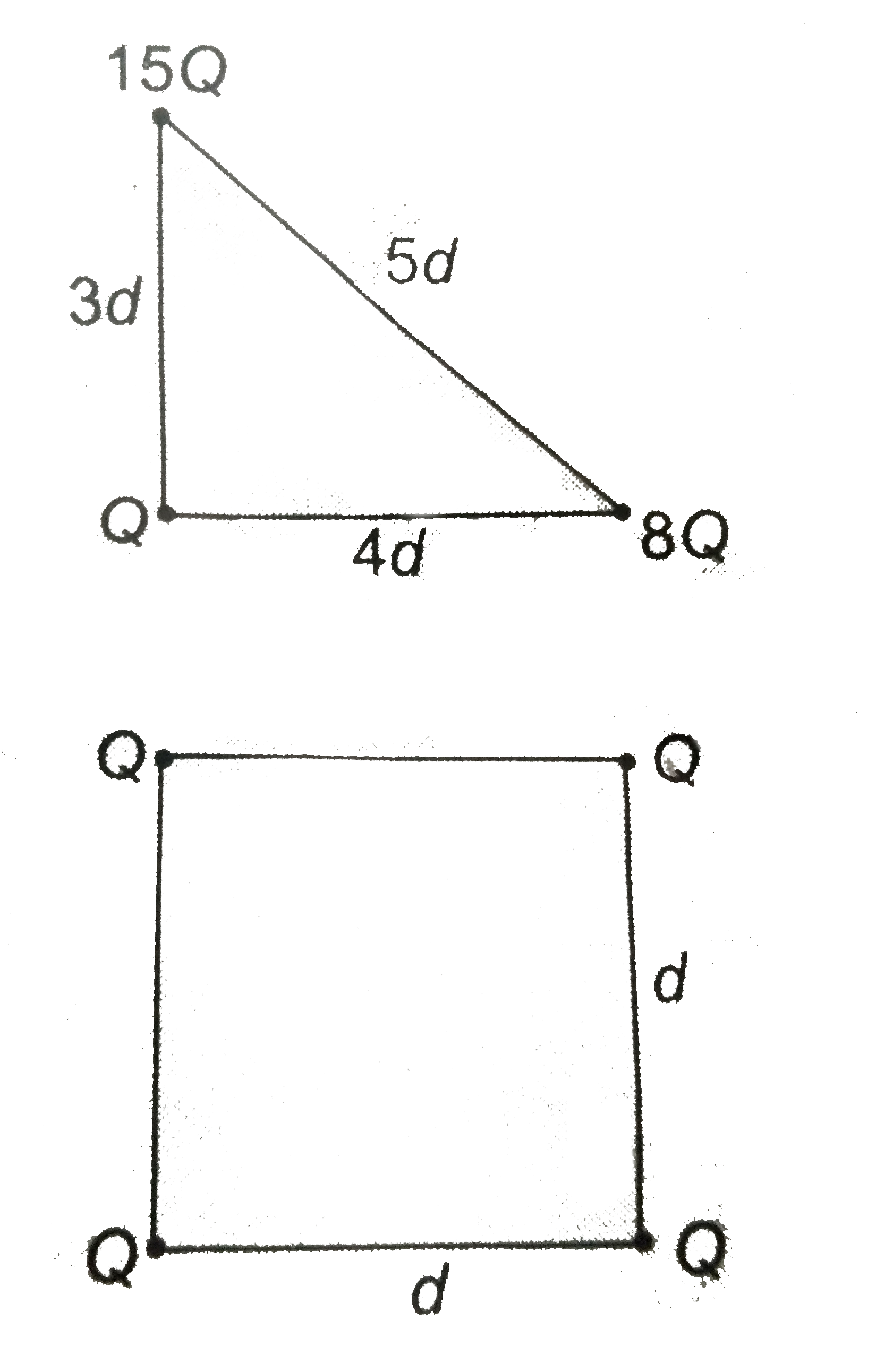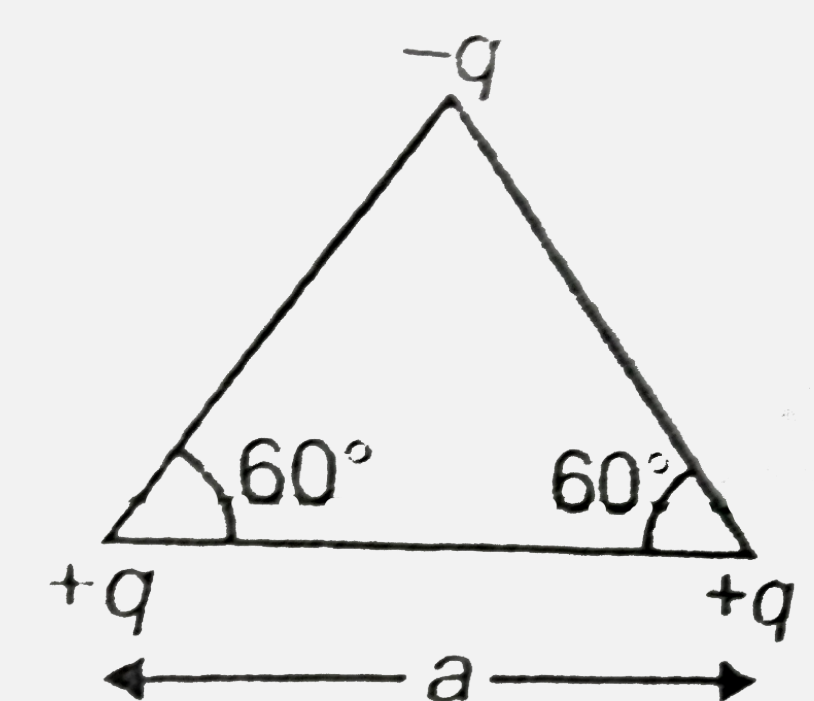Which statement about a system of point charges that are fixed in space is necessarily true? Assuming electrostatic potential energy at infinity to be zero.
If the electrostatic potential energy of the system is negative, net positive work by an external agent is required to take the charges in the system back to infinity.
If the electrostatic potential energy of the system is zero, all charges in the configuration cannot have same sign.
If the electrostatic potential energy of the system is negative, net positive work by an external agent was required to assemble the system of charges.
If the electrostatic potential energy of the system is negative, then there is no electric force anywhere in space on any other charged particle not part of the system.
The correct Answer is:A, B
To solve the question regarding the system of point charges that are fixed in space, we need to analyze the properties of electrostatic potential energy and the implications of its values.
1. Understanding Electrostatic Potential Energy (U):
The electrostatic potential energy of a system of point charges is defined as the work done to assemble the charges from infinity to their respective positions. The formula for the potential energy between two point charges q1 and q2 separated by a distance r is given by:
U=k⋅q1⋅q2r
where k is Coulomb's constant.
2. Potential Energy for Multiple Charges:
For a system of multiple charges, the total potential energy U can be calculated by summing the potential energies of all unique pairs of charges:
U=12n∑i=1n∑j=1,j≠ik⋅qi⋅qjrij
Here, rij is the distance between charges qi and qj.
3. Analyzing the Sign of Potential Energy:
- If the potential energy U is negative, it indicates that work must be done against the attractive forces to separate the charges to infinity. Thus, positive work is required to disassemble the system.
- If U is zero, it implies that the system is in a neutral state where the forces are balanced, and no work is required to move the charges to infinity.
4. Evaluating the Statements:
- Statement 1: "If the electrostatic potential energy of a system is negative, then net positive work by an external agent is required to take the charges in the system back to infinity." This statement is true.
- Statement 2: "If the electrostatic potential energy of a system is zero, then all the charges in the configuration cannot have the same sign." This statement is also true because if all charges had the same sign, the potential energy would be positive.
- Statement 3: "If the electrostatic potential energy is negative, then net positive work was required to assemble the system of charges." This statement is false; negative potential energy indicates that work was done by the system to assemble the charges.
5. Conclusion:
From the analysis, we conclude that statements 1 and 2 are necessarily true regarding the system of point charges.
Final Answer:
The statements that are necessarily true are:
1. If the electrostatic potential energy of a system is negative, then net positive work by an external agent is required to take the charges in the system back to infinity.
2. If the electrostatic potential energy of a system is zero, then all the charges in the configuration cannot have the same sign.
The electrostatic potential energy of a system of point charges is defined as the work done to assemble the charges from infinity to their respective positions. The formula for the potential energy between two point charges q1 and q2 separated by a distance r is given by:
U=k⋅q1⋅q2r
where k is Coulomb's constant.
For a system of multiple charges, the total potential energy U can be calculated by summing the potential energies of all unique pairs of charges:
U=12n∑i=1n∑j=1,j≠ik⋅qi⋅qjrij
Here, rij is the distance between charges qi and qj.
- If the potential energy U is negative, it indicates that work must be done against the attractive forces to separate the charges to infinity. Thus, positive work is required to disassemble the system.
- If U is zero, it implies that the system is in a neutral state where the forces are balanced, and no work is required to move the charges to infinity.
- Statement 1: "If the electrostatic potential energy of a system is negative, then net positive work by an external agent is required to take the charges in the system back to infinity." This statement is true.
- Statement 2: "If the electrostatic potential energy of a system is zero, then all the charges in the configuration cannot have the same sign." This statement is also true because if all charges had the same sign, the potential energy would be positive.
- Statement 3: "If the electrostatic potential energy is negative, then net positive work was required to assemble the system of charges." This statement is false; negative potential energy indicates that work was done by the system to assemble the charges.
5. Conclusion:
From the analysis, we conclude that statements 1 and 2 are necessarily true regarding the system of point charges.
The statements that are necessarily true are:
1. If the electrostatic potential energy of a system is negative, then net positive work by an external agent is required to take the charges in the system back to infinity.
2. If the electrostatic potential energy of a system is zero, then all the charges in the configuration cannot have the same sign.
Topper's Solved these Questions
- ELECTRIC POTENTIALBOOK - RESNICK AND HALLIDAYCHAPTER - ELECTRIC POTENTIALEXERCISE - (PRACTICE QUESTIONS) Linked Comprehension
2 Videos
- ELECTRIC POTENTIALBOOK - RESNICK AND HALLIDAYCHAPTER - ELECTRIC POTENTIALEXERCISE - (PRACTICE QUESTIONS) Matrix-Match
4 Videos
- ELECTRIC POTENTIALBOOK - RESNICK AND HALLIDAYCHAPTER - ELECTRIC POTENTIALEXERCISE - (PRACTICE QUESTIONS) Single Correct Choice Type
21 Videos
- ELECTRIC CHARGES AND FIELDSBOOK - RESNICK AND HALLIDAYCHAPTER - ELECTRIC CHARGES AND FIELDSEXERCISE - Practice Questions (Integer Type )
3 Videos
- ELECTROMAGNETIC INDUCTIONBOOK - RESNICK AND HALLIDAYCHAPTER - ELECTROMAGNETIC INDUCTIONEXERCISE - PRACTICE QUESTIONS (Integer Type)
14 Videos
Similar Questions
Knowledge Check
Which statement about the autonomic nervous system is true ?
AThe sympathetic division is afferent, and the parasympathetic division is efferent.BEach pathway in the autonomic nervous system includes the neurons , and the neurotransmitter of the first neuron is acetylcholine.CThe cell bodies of many sympathetic preganglionic neuron are in the brain stem.DThe cell bodies of most parsympathetic post ganglionic neurons are in or near the thoracic and lumber spinal cord.Consider a solid cube made up of insulating material having a uniform volume charge density. Assuming the electrostatic potential to be zero at infinity, the ratio of the potential at a corner of the cube to that at the centre will be
A1:1B1:2C1:4D1:8In bringing an electron towards another electron, the electrostatic potential energy of the system
AdecreasesBincreasesCremains sameDbecomes zero
Find the electric potential energy of the system of charges.
(a)
View SolutionTwo point charges 4Q, Q are separated by 1m in air. At what point on the line joining the charges is the electric field intensity zero ?
Also calculate the electrostatic potential energy of the system of charges, taking the value of charge, Q=2×10−7C.
View SolutionCalculation OF charge in space by E ||Electrostatic Potential
View SolutionHow much is the electric potential of a charge at a point at Infinity?
View SolutionIn bringing an electron towards another electron, the electrostatic potential energy of the system
View Solution

